Ah, Internets, how I missed you. An outage of just over 24 hours had me in full white-knuckle withdrawal mode. I don’t know how the Harvey/Irma folks can stand it. Take, for instance, the staff of the Hemingway Home and Museum on Key West. Key West, like all of the Florida Keys, was smack in Irma’s path, and the Overseas Highway, its sole road linking it to the mainland, was sure to be underwater leaving Key West without means of resupply. Residents were ordered by the governor to evacuate the Keys. The National Weather Service minced no words, warning that “nowhere in the Florida Keys will be safe” from Irma. Governor Rick Scott minced even fewer words: “You will not survive.”
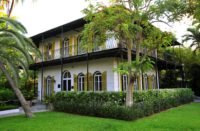 One museum curator, 10 museums staffers and more than 50 cats were not persuaded. Curator of the Hemingway Home and Museum Dave Gonzales chose to stay in the historic property once inhabited by Ernest Hemingway and 10 staffers joined him. Perhaps even more beloved (and certainly better known) than the mere humans are the cats, most of them polydactyl, descended from the author’s original cats.
One museum curator, 10 museums staffers and more than 50 cats were not persuaded. Curator of the Hemingway Home and Museum Dave Gonzales chose to stay in the historic property once inhabited by Ernest Hemingway and 10 staffers joined him. Perhaps even more beloved (and certainly better known) than the mere humans are the cats, most of them polydactyl, descended from the author’s original cats.
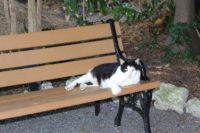 Hemingway loved cats and ended up with more than 50 of them. He had a great fondness for polydactyls which were considered good luck on board ships. It was a sea captain who gave Hemingway his first polydactyl, Snowball. Today the descendants of Snowball and his feline family live on the estate and have the run of the place, just as the cats did when Hemingway lived there. Most of them are neutered, with only a select few allowed to breed very rarely to ensure the population remains steady at around 50. Named after the greatest stars of pop culture, they are so famous and so popular that polydactyls, particularly those with little thumbs that make them look like they’re wearing boxing gloves, are commonly known as Hemingways. Half of the visitors to the Hemingway Home and Museum go there just to see the cats.
Hemingway loved cats and ended up with more than 50 of them. He had a great fondness for polydactyls which were considered good luck on board ships. It was a sea captain who gave Hemingway his first polydactyl, Snowball. Today the descendants of Snowball and his feline family live on the estate and have the run of the place, just as the cats did when Hemingway lived there. Most of them are neutered, with only a select few allowed to breed very rarely to ensure the population remains steady at around 50. Named after the greatest stars of pop culture, they are so famous and so popular that polydactyls, particularly those with little thumbs that make them look like they’re wearing boxing gloves, are commonly known as Hemingways. Half of the visitors to the Hemingway Home and Museum go there just to see the cats.
Nobel-prize winning novelist Ernest Hemingway’s home on Key West has many of his personal belongings on display from furniture to pens, and of course it has its greatest stars roaming the grounds, but it is a National Historic Landmark whose history long predates Hemingway’s residence. The white Spanish colonial mansion was built in 1851 by marine architect Asa Tift. A ship’s captain and salvage wrecker who was well-versed in the challenges of building on a small island that is almost entirely at sea level, Tift chose his site wisely. He picked the second highest point in Key West at 16 feet above sea level and then quarried its limestone. That provided his home with a deep, dry basement and a supply of 18-inch blocks carved from solid limestone with which to build it.
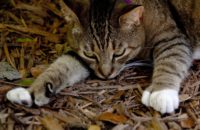 A family squabble kept the old Tift mansion boarded up and abandoned until Ernest Hemingway bought it in 1931 for $8,000. He lived in the home with his second wife Patricia and their two sons from 1931 until 1940. Those brief nine years were exceptionally prolific, the most productive of his life. He wrote 70% of his total output during those years, including To Have and Have Not, Death in the Afternoon and For Whom the Bell Tolls. He also paid a nosebleed-inducing $20,000 to have the first in-ground pool in Key West installed in 1938. Two years later and three years after he began his affair with Martha Gellhorn, Ernest moved to Cuba, got a divorce and got remarried to Gellhorn three weeks after it was finalized.
A family squabble kept the old Tift mansion boarded up and abandoned until Ernest Hemingway bought it in 1931 for $8,000. He lived in the home with his second wife Patricia and their two sons from 1931 until 1940. Those brief nine years were exceptionally prolific, the most productive of his life. He wrote 70% of his total output during those years, including To Have and Have Not, Death in the Afternoon and For Whom the Bell Tolls. He also paid a nosebleed-inducing $20,000 to have the first in-ground pool in Key West installed in 1938. Two years later and three years after he began his affair with Martha Gellhorn, Ernest moved to Cuba, got a divorce and got remarried to Gellhorn three weeks after it was finalized.
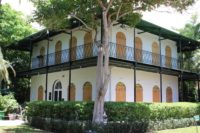 He kept the house until his death, although he never lived in it again. He died in 1961 and his widow (wife #4, Mary Welsh) sold it to Bernice Dickson who would transform it into a museum. In all this time, through the dozens (hundreds?) of hurricanes and crazy storms it has seen since 1851, the Hemingway Home has always held out against the elements. Its basement doesn’t flood. Its walls remain unbreached. That’s why Gonzales is so confident in the Hemingway Home’s capacity to weather even a monster hurricane like Irma. Only Solares Hill (18 feet above sea level) is at a higher elevation than the Hemingway estate, and its massive limestone construction and deep basement make it one of the safest places, if not the safest, on the island. It also has an array of generators for power and climate control. The ten employees who are joining Gonzales live at lower elevations on the island and have chosen to seek shelter behind those thick limestone blocks.
He kept the house until his death, although he never lived in it again. He died in 1961 and his widow (wife #4, Mary Welsh) sold it to Bernice Dickson who would transform it into a museum. In all this time, through the dozens (hundreds?) of hurricanes and crazy storms it has seen since 1851, the Hemingway Home has always held out against the elements. Its basement doesn’t flood. Its walls remain unbreached. That’s why Gonzales is so confident in the Hemingway Home’s capacity to weather even a monster hurricane like Irma. Only Solares Hill (18 feet above sea level) is at a higher elevation than the Hemingway estate, and its massive limestone construction and deep basement make it one of the safest places, if not the safest, on the island. It also has an array of generators for power and climate control. The ten employees who are joining Gonzales live at lower elevations on the island and have chosen to seek shelter behind those thick limestone blocks.
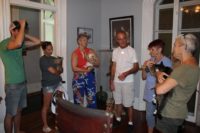 Besides, somebody has to take care of the cats. The staff helped round them all up and bring them indoors to safety. Father John Baker from St. Mary’s Star of the Sea Basilica (one of the oldest Catholic parishes in Florida and Pauline Hemingway’s parish when she lived at Hemingway Home) blessed the staff and cats.
Besides, somebody has to take care of the cats. The staff helped round them all up and bring them indoors to safety. Father John Baker from St. Mary’s Star of the Sea Basilica (one of the oldest Catholic parishes in Florida and Pauline Hemingway’s parish when she lived at Hemingway Home) blessed the staff and cats.
Window and shutters nailed down under plywood, fully stocked with supplies, safe and dry in a basement that has never flooded, Gonzales, the staff and the cats stared Irma down. She was no match for them. From the Hemingway Home Cats Instagram page:
We are so extremely happy to announce that everyone, cats and staff, have weathered the storm and are only reporting trees down on property as far as damage goes. Communication with the Hurricane crew is incredibly limited and they currently do not have power, water, phones or internet. We do not have any photos to share at this time. Nicole was our only admin for the page that stayed on the hurricane crew. She will share when internet access is available. Please keep in mind that clean up is already underway and therefore we will not be posting anything more until normal communication services are available on the island. We appreciate the concern and well wishes.
Here’s a great tour of the Hemingway Home and Museum led by Dave Gonzales, whose handsome snowy beard may or may not be related to Hemingway’s iconic facial hair.
And here is an extremely badass cat with many toes ideally positioned for the pummelling of interlopers keeping Ernest Hemingway’s typewriter from harm.
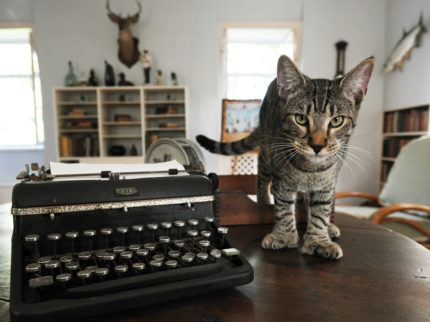
GOOD NEWS ! – Moreover, 40 percent of ‘Maine-Coon’ type felines are said to be polydactyle, and their ancestors could have been brought over from e.g. Siberia as from Norway as well. However, cats in general can hardly ever be ‘persuaded’ to leave – to leave in order to visit another of their -already well established- homes is a rare exception.
————————–
PS: Once, I accidentally disturbed a young lynx. Those -of course- have standard paws, but theirs are huge. Thus, he ran over all the foliage with great ease and -maybe- the idea of polydactyle ‘forest cats’ is a similar one. On sand, their paws might also be helpful.
Yeah! You are back :boogie:
If Irma had tracked just a few more miles west, this wouldn’t be a happy tail at all. It’s one of the few bits of good news out of the Lower and Middle Keys. 🙁
I have a polydactal cat lol
The cat must have walked across the keyboard of that typewriter! The keys are all jammed up!
Thanks for the interesting post. Glad you are safe and can lead us on to more adventures.
The house must have been a circus with 50 cats inside! My cats (far fewer) were restless enough after three days of Harvey rains.
The typewriter cat has great paws. Those toes have to make fine burglar tools. There’s probably not many cupboards he can’t open.
We share space with Blotto, son of Blackadder, a black micropanther with monstrous paws.
My suspicion is that they’re trying to evolve opposable thumbs, at which point they’ll be able to do without us and they’ll murder us in our beds.
Living proof cats indeed have Nine Lives. Hope this theory is never tested by the weather demons hurling another eight hurricanes at Key West.
My belief is that even polydactyl cats who evolve opposable thumbs, will never do away with their monkey servants. We are too convenient. As witnessed by the faithful monkey servants who fed the Hemingway cats during the storm. 😉